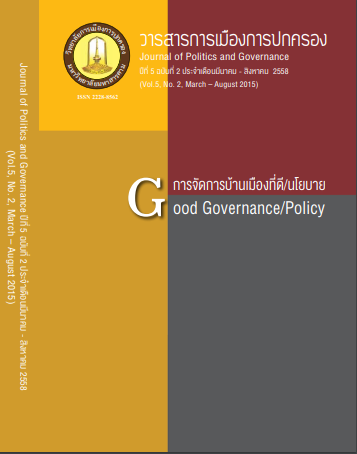Financing Universal Healthcare and the ASEAN: Focus on the Philippine Sin Tax Law
Main Article Content
บทคัดย่อ
This paper looks at the possible impact of the ASEAN integration in the region as well as the challenges it brings especially on the goal of financing health care. This study analyzes how a reform measure, the sin tax law, imposing tax on cigarettes and alcohol, was passed into law considering its conflicting role of being a revenue measure but at the same time a regulatory and health measure. The new law which supports the goal of achieving universal health care coverage is actually a revenue raising measure considering its nature as a tax law. However, under the present administration’s drive to institute reforms in governance, this policy reform deviates from this nature and seeks to fulfill a social goal of improving not only universal health coverage but also lower tobacco and liquor related health problems among the youth.
Data from other countries was also used in the analysis to see how the present law compares with current and past prices of alcohol, liquor and cigarettes and how international organizations affected the passage of the measure.
Article Details

อนุญาตภายใต้เงื่อนไข Creative Commons Attribution-NonCommercial-NoDerivatives 4.0 International License.
เอกสารอ้างอิง
ASEAN. (2007). ASEAN Economic Community Blueprint.
Asian Development Bank. (2013). The Road to ASEAN Financial Integration. ADB
Balboa, Jenny, Medalla, Erlinda and Yap, Josef. (2007). “Closer Trade and Financial Co-operation in ASEAN: Issues at the Regional and National Level with Focus on the Philippines.” ASEAN Economic Bulletin April 2007: 119-137.
Bird, Rirchard and de Jantcher Milka Casanega ed. (1992). Imrproving Tax Administration in Developing Countries
Brillantes, Alex Jr. (1980). “ The Regional Development Council as a Mechanism for Coordination and Effective Performance: Focus on Region III” at PJPA Vol XXIV.
Brillantes, Alex Jr. (1996). Decentralization, Devolution and Democratization. Old Concepts, Contemporary Applications. Kasarinlan vol 12 No. 1 3rd Quarter 1996
Brillantes, Alex Jr. and Moscare, Donna. (2002).“Decentralization and Federalism in the Philippines: Lessons from Global Community,” a paper presented at the International Conference of the East West Center Kuala Lumpur, Malaysia
Brillantes, Alex Jr. (2003). Innovations and Excellence. Center for Local and Regional Governance. CLRG, UP-NCPAG
Capuno, Joseph. (2009). A Case Study of Decentralization of Health and Education Services in the Philippines. Human Development Network Discussion Paper Series PHDN 2008/2009 No. 3
Capuno, Joseph J. (2006). “Social Health Insurance for the Poor Programs of the Philippines and Vietnam,” in Philippine Journal of Development, 61:1st and 2nd Semesters. Vol 33:1&2.
Chongsuviratwong, Urasakdi, Kai Hong Phua, Mui Teng Yap, et al. (2011).“Health and Health Care Systems in Southeast Asia: Diversity and Transition.” Lancet 2011: 377-429.
Congressional Policy and Budget Research Department (CPBRD). (2013). Maximizing the Gains from the ASEAN Economic Community: The Philippines Amid the Process of ASEAN Integration. 2013. House of Representatives
Department of HealthThe Philippine Health System at a Glance Chapter 1 at http://www.doh.gov.ph/sites/default/files/3%20Chapter1.pdf
DOH. (2005). DOH National Objectives for Health 2005-2010.
Gupta, Inadrani and Swadhin Mondal. (2013). “Fiscal Space for Health Spending in Southeast Asia” in Journal in Health Care Finance 2013: 39 (4) 68-82
Grundy J., Healy V., Gorogolon L. Sandig E. (2003). Overview of Devolution of Health Services in the
Philippines at http://www.rrh.org.au/publishedarticles/article_print_220.pdf
Haw, Dennis. (2003).Realizing the ASEAN Economic Community. ASEAN Economic Bulletin vol. 20 NO. 3 pp. 292-296
Hockley, Graham. (1992). Fiscal Policy An Introduction. Routledge.
Ilago Simeon. (2004). Reform as Policy Theory: The Case of Public Management Reform in the Philippines in Philippine Journal of Public Administration XLVIII No. 3.
Lecciones, Julius. (2004). Post Modernism in 21st Century Medicine: Implications for Philippine Healthcare and Public Administration in PJPA vol XLVIII No. 3
Lagomarsino,G., Agrrabrant, A., Attila A., Mugo, R. (2012). Moving Towards Universal Health Insurance. The Lancet vol. 360.
Llanto, Gilberto. (2007). Protecting the Vulnerable Through Social Health Insurance: Philhealth’s KASAPI as Strategy. PIDS Policy Notes.
Manasan, Rosario et al. (2011). Mobilizing LGU support for Basic Education: Focus on the Special Education Fund. PIDS Discussion Paper Series 2011-07. May
Manasan, Rosario G. (2011). “Expanding Social Health Insurance Coverage: New Issues and Challenges,” PIDS Discussion Paper Series No. 2011-21, December.
Philippine Health Insurance Corporation. (2013). Data on Membership, 1997-2013.
Picazo, O. F., Ulep, V. T., Aldeon, M. P., Dela Cruz, N. O., & Ortiz, D. (2013).
Explaining the large disparities in health in the Philippines (PIDS Policy Notes). Makati City: Philippine Institute for Development Studies.
Picazo, Oscar. (2011). Review of Cheaper Medicines. PIDS at www.dbm.gov.ph.
Reece, Rob. (2012). Excise Taxation of Commodities Across South East Asia in World in World Customs Journal 2012.
Republic Act 7875. (1995). An Act Instituting a National Health Insurance Program for All Filipinos and Establishing The Philippine Health Insurance Corporation for the Purpose.
Republic Act 10351. (2012)A n Act Restructuring The Excise Tax On Alcohol and Tobacco Products By Amending Sections 141, 142, 143, 144, 145, 8, 131 And 288 of Republic Act No. 8424. Otherwise Known as The National Internal Revenue Code of 1997, as Amended by Republic Act No. 9334, And for other Purposes.
Republic Act 10606. (2013). An Act Amending Republic Act No. 7875, otherwise known as the National Health Insurance Act of 1995, As Amended and for Other Purposes.
Stokey, Edith and R. Zeckhauser. (1978). Norton and Company Inc.
Sackman, Jill. (2013). “Navigating Emerging Markets: Southeast Asia” in BioPharm International.
Xun Wu and M. Ramesh. (2009). Health Care Reforms in Developing Asia: Propositions and Realities. Development and Change 40(3): 531–549 (2009). C Institute of Social Studies. Published by Blackwell Publishing, 9600 Garsington Road, Oxford OX4 2DQ, UK and 350 Main St., Malden, MA 02148, USA
Internet Sites
www.dof.gov.ph
http://www.internationaltaxreview.com
www.asean.org
Position Papers by:
Department of Finance
Department of Health
Philippine College of Chest Physicians


